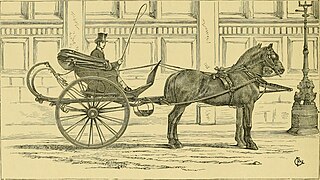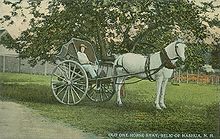
A carriage is a two- or four-wheeled horse-drawn vehicle for passengers. Second-hand private carriages were common public transport, the equivalent of modern cars used as taxis. Carriage suspensions are by leather strapping or, on those made in recent centuries, steel springs. Two-wheeled carriages are usually owner-driven.

The hansom cab is a kind of horse-drawn carriage designed and patented in 1834 by Joseph Hansom, an architect from York. The vehicle was developed and tested by Hansom in Hinckley, Leicestershire, England. Originally called the Hansom safety cab, it was designed to combine speed with safety, with a low centre of gravity for safe cornering. Hansom's original design was modified by John Chapman and several others to improve its practicability, but retained Hansom's name.

A buggy refers to a lightweight four-wheeled carriage drawn by a single horse, though occasionally by two. Amish buggies are still regularly in use on the roadways of America. The word "buggy" has become a generic term for "carriage" in America.

A curricle is a light two-wheeled carriage drawn by two horses abreast. Usually open with a falling hood, it seats two people, plus a liveried groom on a seat or small platform between the rear springs—whose weight might be required to properly balance the carriage. Curricles are harnessed with a pole between the horses, and have an iron crossbar which rests over the harness saddle and supports the weight of the pole. The lightweight "swept" body is hung from a pair of outsized swan-neck cee-springs at the rear, with a minimal dashboard and a pair of lamps in front. For park driving, such as in the Bois de Boulogne or along the seafront at Honfleur, two liveried mounted grooms might follow.

A post-chaise is a fast carriage for traveling post built in the 18th and early 19th centuries. It usually had a closed body on four wheels, sat two to four persons, and was drawn by two or four horses.

A gig is a light, two-wheeled open carriage with large wheels, a forward facing seat, and shafts for a single horse. The gig's body is constructed above the shafts, and it is entered from step-irons hanging from the shaft in front of the wheels. Gigs are enclosed at the back, and have luggage space under the cross-seat. Early gigs were crude and unsprung; later gigs were elegant for town driving and were constructed with springs. The term "gig" is short for "whirligig".

A horse-drawn vehicle is a piece of equipment pulled by one or more horses. These vehicles typically have two or four wheels and were used to carry passengers or a load. They were once common worldwide, but they have mostly been replaced by automobiles and other forms of self-propelled transport but are still in use today.

A postilion or postillion is a person who guides a horse-drawn coach or post chaise while mounted on the horse or one of a pair of horses. By contrast, a coachman controls the horses from the vehicle itself.

A dogcart is a two-wheeled horse-drawn vehicle pulled by a single horse in shafts, or driven tandem. With seating for four, it was designed for sporting shooters and their gun dogs, with a louvred box under the driver's seat to contain dogs. It was developed in the early 1800s to afford more seating than the gig, which seats only two. Seating is two back-to-back crosswise seats, an arrangement called dos-à-dos from French. There is a hinged tailboard which lowers slightly and, supported by chains, acts as a footrest for the rear-facing passengers. Some dogcarts had a mechanism to slide the entire body forward or rearward along the shafts to help balance the weight for the horse.

A tonga or tanga is a two-wheeled cart drawn by a single horse. It is used for transportation in the Indian subcontinent. There is a canopy over the body, one seat faces forward for the driver and one passenger, and one seat faces the rear for a second passenger. Some space is available for baggage below the carriage, between the wheels. This space is often used to carry hay for the horses.

In coachbuilding, a landau is a four-wheeled carriage with a roof that can be let down. It was a luxury carriage. The low shell of the landau provides maximal visibility of the occupants and their clothing, a feature that makes a landau still a popular choice for Lord Mayors in the United Kingdom on ceremonial occasions.

A droshky or drosky is a term used for a four-wheeled open carriage used especially in Russia. The vehicle has a long bench on which the driver or passengers sit as if on a saddle, either astride or sideways. From droga, the pole that connects the front and rear axles.

A trap, pony trap or horse trap is a light, often sporty, two-wheeled or sometimes four-wheeled horse- or pony-drawn carriage, usually accommodating two to four persons in various seating arrangements, such as face-to-face or back-to-back. In the eighteenth century, the first carriage to be called a trap was a gig with a hinged trap door, under which was a place to carry a dog. In late nineteenth century USA, four-wheeled dog carts with convertible seats also started to become known as traps.

Volante is a two-wheeled open carriage with a retractable hood that was popular in Cuba in the mid-1800s. The vehicle was directed by a postilion rider. The large wheels are positioned behind the seat and are over 6 feet in diameter with an 8.5 inch hub. Most of the volantes were imported to Cuba from England, France, or the United States.

A cabriolet is a light horse-drawn vehicle, with two wheels and a single horse. The carriage has a folding hood that can cover its two occupants, one of whom is the driver. It has a large rigid apron, upward-curving shafts, and usually a rear platform between the C springs for a groom. The design was developed in France in the eighteenth century and quickly replaced the heavier hackney carriage as the vehicle for hire of choice in Paris and London.
In economics, depreciation is the gradual decrease in the economic value of the capital stock of a firm, nation or other entity, either through physical depreciation, obsolescence or changes in the demand for the services of the capital in question. If the capital stock is in one period , gross (total) investment spending on newly produced capital is and depreciation is , the capital stock in the next period, , is . The net increment to the capital stock is the difference between gross investment and depreciation, and is called net investment.

William Felton was a London coachmaker from 36 Leather Lane in Holborn, and 254 Oxford Street near Grosvenor Square, and noted for his 1796 illustrated two-volume book, A Treatise on Carriages; comprehending Coaches, Chariots, Phaetons, Curricles, Gigs, Whiskies, &c Together with their Proper Harness in which the Fair Prices of Every Article are Accurately Stated.

A stage station or relay station, also known as a staging post, a posting station, or a stage stop, is a facility along a main road or trade route where a traveller can rest and/or replace exhausted working animals for fresh ones, since long journeys are much faster with fewer delays when using well fed and rested mounts. Stage is the space between the places known as stations or stops — also known in British English as posts or relays.

A state coach, also known as a gala coach, is a highly decorative ceremonial coach used in Europe by a monarch or head of state on state occasions. A four-wheeled vehicle for four passengers, it may be drawn at a walk by six or more horses with postilions, or be driven by two or more horses. The term is also used to indicate a formal town coach used by nobility and the wealthy for formal occasions, drawn by a pair of matching horses.

A Sjees is a traditional Dutch two-wheeled carriage pulled by one or two horses, which originates from Friesland in the north of Netherlands. Also called a Friesian chaise, it resembles a chaise or gig carriage but with unique regional distinctions. The undercarriage, wooden axle, large wheels, and shafts are usually painted white. The body, which is supported on cee-springs and leather braces, has a curved dash and seats two people. Typically, the body is decorated with elaborate painting, gilding and carvings, and the upholstery is brightly colored velvet or leather.
























